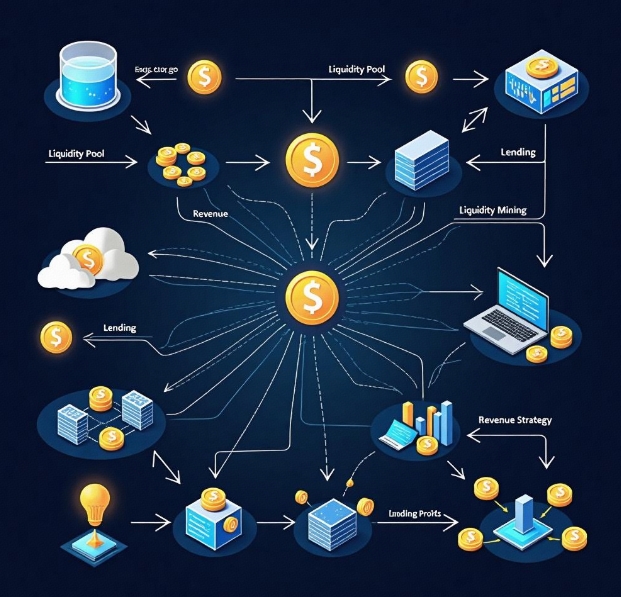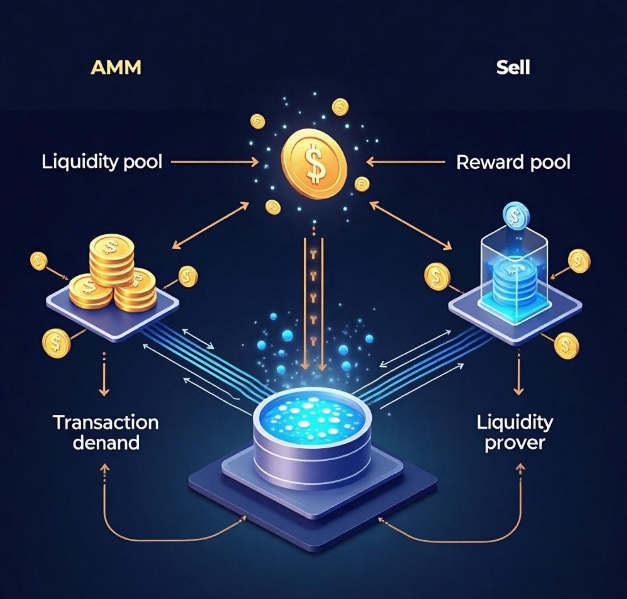DeFi DApp Development: Detailed Explanation of Liquidity Pools and Yield Strategies
- latest articles
- 1.DApp Development & Customization: Merging Diverse Market Needs with User Experience 2.Analysis of the Core Technical System in DApp Project Development 3.How to achieve cross-chain interoperability in Web3 projects? 4.How does the tokenization of points reconstruct the e-commerce ecosystem? 5.How to Set and Track Data Metrics for a Points Mall? 6.What is DApp Development? Core Concepts and Technical Analysis 7.Inventory of commonly used Web3 development tools and usage tips 8.Development of a Distribution System Integrated with Social E-commerce 9.Six Key Steps for Businesses to Build a Points Mall System 10.What is DApp Development? A Comprehensive Guide from Concept to Implementation
- Popular Articles
- 1.Future Trends and Technology Predictions for APP Development in 2025 2.Analysis of the DeFi Ecosystem: How Developers Can Participate in Decentralized Finance Innovation 3.From Zero to One: How PI Mall Revolutionizes the Traditional E-commerce Model 4.DAPP Development | Best Practices for Professional Customization and Rapid Launch 5.Recommended by the Web3 developer community: the most noteworthy forums and resources 6.From Cloud Computing to Computing Power Leasing: Building a Flexible and Scalable Computing Resource Platform 7.How to Develop a Successful Douyin Mini Program: Technical Architecture and Best Practices 8.Shared Bike System APP: The Convenient Choice in the Era of Smart Travel 9.How to Create a Successful Dating App: From Needs Analysis to User Experience Design 10.From Design to Development: The Complete Process of Bringing an APP Idea to Life
With the continuous development of blockchain technology, Decentralized Finance (DeFi) has become a vital component of the blockchain ecosystem. DeFi applications (DApps) leverage smart contracts to decentralize traditional financial services, including lending, trading, and asset management. Compared to traditional financial systems, the greatest advantages of DeFi lie in its disintermediation, global reach, and 24/7 operation. For developers, the challenges in building DeFi DApps extend beyond technical implementation to designing sound mechanisms, ensuring fund security, and enhancing user experience.
Among these, Liquidity Pools (LP) and Yield Strategies are two crucial concepts in the DeFi ecosystem. They are not only core components of DeFi DApps but also directly impact user participation and platform success. This article will provide a detailed analysis of liquidity pools and yield strategies in DeFi DApps and explore how thoughtful design can enhance a DApp's appeal and utility.
I. The Concept and Principles of Liquidity Pools
1. Basic Concept of Liquidity Pools
A liquidity pool is a smart contract mechanism used in decentralized exchanges (DEX) and other DeFi protocols to provide trading liquidity. It consists of two or more asset pairs (e.g., ETH/USDT, BTC/ETH). Liquidity Providers (LPs) deposit their assets into the liquidity pool, thereby providing liquidity for traders. Liquidity pools are not only used on decentralized trading platforms but also support DeFi applications like lending platforms, derivatives trading, and stablecoins.
The primary advantage of liquidity pools is their ability to replace traditional order books with algorithms, enabling order book-free decentralized trading. This allows liquidity pools to automatically match buy and sell orders, addressing the issue of insufficient liquidity in traditional markets.
2. How Liquidity Pools Work
Liquidity pools are typically governed by smart contracts and operate based on predefined algorithms. For example, in a common Automated Market Maker (AMM) model, the pool uses the Constant Product Market Maker (CPMM) model, with the formula:
Here, x and y represent the quantities of the two assets in the pool, and k is a constant. When a trade occurs, the asset quantities in the pool change accordingly, but the constant product value remains unchanged. This formula is used to calculate the liquidity users need to provide for trades and the asset ratios in the pool post-trade.
Through this mechanism, liquidity pools can offer instant trading without relying on traditional buy and sell order books.
3. Advantages and Disadvantages of Liquidity Pools
Advantages:
Decentralization and Openness: Liquidity pools allow anyone to participate without needing centralized exchanges or platforms, lowering the entry barrier.
High Trading Efficiency: Users can trade at any time without waiting for counterparty matching.
Profit Sharing: Liquidity providers earn a share of transaction fees as rewards for supplying funds to the pool.
Disadvantages:
Impermanent Loss: When asset prices in the liquidity pool fluctuate, liquidity providers may suffer impermanent loss. This refers to the scenario where the relative value of assets deposited into the pool changes, resulting in a lower value upon withdrawal compared to the initial deposit.
Smart Contract Risk: Liquidity pools rely on smart contract execution; vulnerabilities in the contract can lead to fund loss or hacking attacks.
II. Design and Implementation of Yield Strategies
1. Basic Concept of Yield Strategies
Yield strategies refer to mechanisms designed by DeFi platforms to provide users with returns. These returns typically come from transaction fees, liquidity mining rewards, lending interest, etc. For DeFi DApp developers, designing reasonable yield strategies can not only attract more users but also increase platform activity and capital liquidity.
Yield strategies in DeFi platforms can be mainly categorized as follows:
Liquidity Mining: Users provide assets to liquidity pools and receive a share of transaction fees or platform-issued tokens as rewards. Liquidity mining is a common yield strategy in the DeFi ecosystem.
Lending Interest: Lending platforms earn interest from loaned funds. This strategy applies to lending platforms where users can earn interest by collateralizing assets, while the platform profits from borrowers' interest.
Staking Rewards: Users stake assets as part of network validation to earn blockchain network rewards. This strategy is often associated with Proof of Stake (PoS) consensus mechanisms.
Yield Aggregation: Yield aggregation platforms optimize the allocation of user funds across different DeFi protocols to maximize returns. After depositing assets into a yield aggregation protocol, the system automatically selects the best yield sources for allocation.
2. Design of Liquidity Mining and Yield Strategies
In DeFi platforms, liquidity mining is one of the most common yield strategies. To attract more liquidity providers, platforms often offer incentive mechanisms, such as distributing platform tokens or high transaction fee returns. When designing liquidity mining rewards, developers need to consider the following factors:
Reward Distribution Mechanism: Platforms can weight rewards for different liquidity pools to encourage users to provide funds to specific pools. For example, higher rewards can be offered for newly listed asset pairs to attract more capital inflow.
Sustainability of Rewards: DeFi platforms need to design reasonable reward mechanisms to ensure sustainability. Excessively high token rewards may lead to token devaluation, affecting long-term platform operation.
Lock-up Period Design: To prevent rapid fund withdrawal, DeFi platforms can implement lock-up periods, requiring liquidity providers not to withdraw their liquidity for a specific duration. This enhances platform fund stability and reduces market volatility.
Impermanent Loss Compensation Mechanism: To mitigate the risk of impermanent loss for liquidity providers, some platforms offer compensation programs to help reduce losses caused by asset price fluctuations.
3. Optimization of Yield Aggregation Strategies
Yield aggregation is an emerging strategy in the DeFi ecosystem that uses smart contracts to allocate user funds across different protocols to maximize returns. Optimizing aggregation strategies involves not only selecting high-yield DeFi protocols but also considering smart contract security, cost efficiency, and liquidity.
When optimizing yield aggregation strategies, developers can take the following measures:
Dynamic Fund Allocation: Adjust fund allocations dynamically based on yield changes in different DeFi protocols. For instance, as annual yields of certain protocols fluctuate with market conditions, platforms can use algorithms to promptly reallocate funds to ensure maximum user returns.
Reducing Transaction Costs: Each fund reallocation in an aggregator may incur transaction fees, so minimizing costs is crucial for optimizing yield aggregation. Developers can choose low-fee DeFi protocols or utilize off-chain computations to reduce unnecessary transactions.
Multi-Chain Support: With the advancement of cross-chain technology, DeFi platforms can support protocols on multiple blockchains, broadening yield sources. Cross-chain support not only enhances fund liquidity but also offers users more profit opportunities.
III. Challenges and Prospects in DeFi DApp Development
1. Security Challenges
In DeFi DApp development, smart contract security remains a critical concern. Once deployed on the blockchain, smart contracts are immutable, and any vulnerability can lead to platform fund loss. To ensure security, developers must conduct rigorous code audits and seek reviews from the community and third-party security firms.
2. Regulatory Compliance Issues
As the DeFi ecosystem flourishes, regulatory bodies worldwide are increasingly scrutinizing DeFi applications. Balancing user interests with legal compliance will be a significant challenge for DeFi platforms.
3. User Experience and Education
Although DeFi offers users greater autonomy and profit opportunities, many DeFi applications still feature complex processes and high barriers to entry. Therefore, simplifying user experience, providing intuitive interfaces, and educating users on understanding and using DeFi products will be key to the future development of DeFi platforms.
IV. Summary
Liquidity pools and yield strategies are indispensable components in DeFi DApp development. By thoughtfully designing these elements, DeFi platforms can offer stable returns and attract more participants. However, as competition in the DeFi market intensifies, platform developers must focus not only on technical implementation but also on security, compliance, and user experience. In the future, with continuous technological innovation and evolving market demands, DeFi platforms will trend towards greater diversification and intelligence.
-

DApp Development & Customization: Merging Diverse Market Needs with User Experience
As blockchain technology matures and becomes more widespread, decentralized appl···
-

Analysis of the Core Technical System in DApp Project Development
With the rapid development of blockchain technology, decentralized applications ···
-

What is DApp Development? Core Concepts and Technical Analysis
With the rapid development of blockchain technology, decentralized applications ···

 Blockchain
Blockchain












